1997 BUICK CENTURY tow
[x] Cancel search: towPage 135 of 406
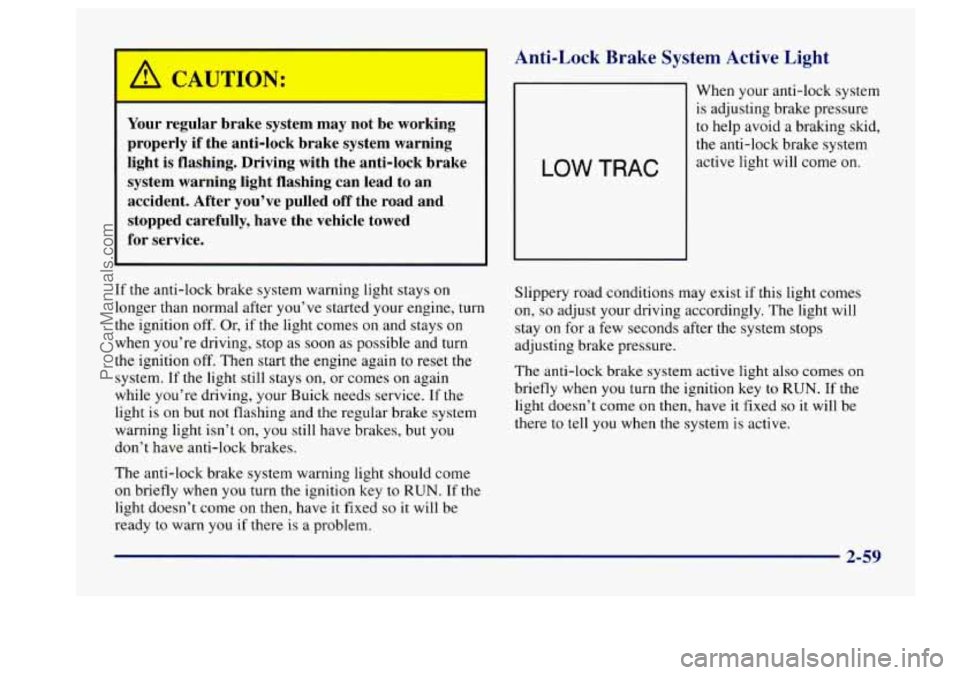
ON:
Your regular brake system may not be working
properly if the anti-lock brake system warning
light is flashing. Driving with the anti-lock brake system warning light flashing can lead
to an
accident. After you’ve pulled off the road and
stopped carefully, have the vehicle towed
for service.
If the anti-lock brake system warning light stays on
longer than normal after you’ve started your engine, turn
the ignition
off. Or, if the light comes on and stays on
when you’re driving, stop as soon as possible and turn
the ignition
off. Then start the engine again to reset the
system. If
the light still stays on, or comes on again
while you’re driving, your Buick needs service, If the
light is
on but not flashing and the regular brake system
warning light isn’t on, you still have brakes, but you
don’t have anti-lock brakes.
The anti-lock brake system warning light should come
on briefly when
you turn the ignition key to RUN. If the
light doesn’t come
on then, have it fixed so it will be
ready to warn you
if there is a problem.
4nti-Lock Brake System Active Light
1
When your anti-lock system
is adjusting brake pressure
to help avoid a braking
skid,
the anti-lock brake system
Slippery road conditions may exist if this light comes
on,
so adjust your driving accordingly. The light will
stay
on for a few seconds after the system stops
adjusting brake pressure.
The anti-lock brake system active light also comes
on
briefly when you turn the ignition key to RUN. If the
light doesn’t come on then, have it fixed
so it will be
there to tell you when the system is active.
2-59
ProCarManuals.com
Page 139 of 406
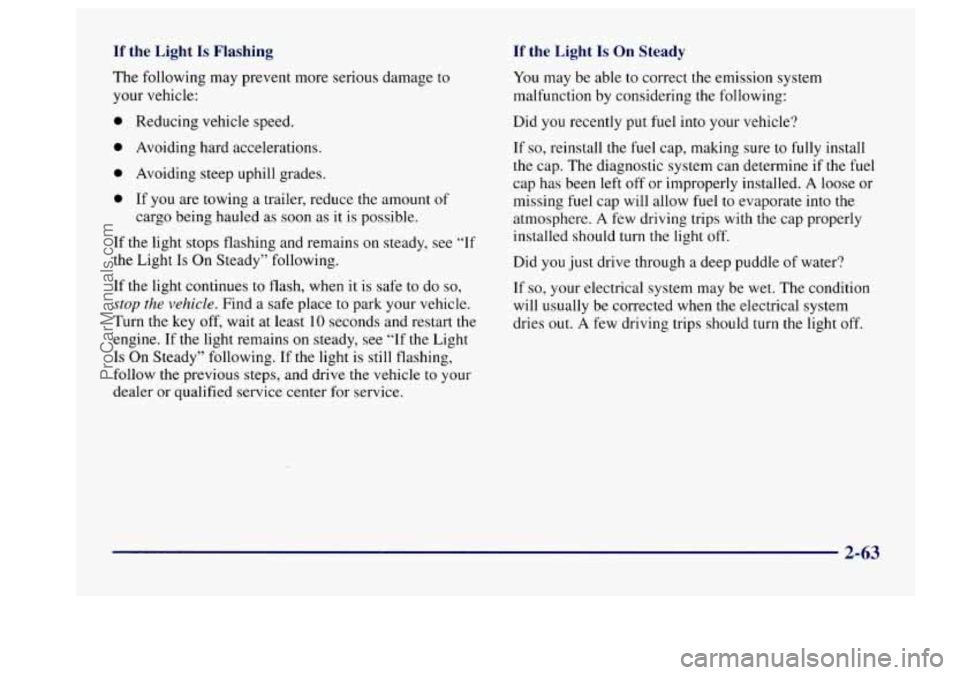
If the Light Is Flashing
The following may prevent more serious damage to
your vehicle:
0 Reducing vehicle speed.
0 Avoiding hard accelerations.
0 Avoiding steep uphill grades.
0 If you are towing a trailer, reduce the amount of
cargo being hauled
as soon as it is possible.
If the light stops flashing and remains on steady, see
“If
the Light Is On Steady” following.
If the light continues to flash, when it is safe to do
so,
stop the vehicle. Find a safe place to park your vehicle.
Turn the key off, wait at least
10 seconds and restart the
engine. If the light remains
on steady, see “If the Light
Is On Steady’’ following.
If the light is still flashing,
follow the previous steps, and drive the vehicle to your
dealer
or qualified service center for service.
If the Light Is On Steady
You may be able to correct the emission system
malfunction by considering the following:
Did you recently put fuel into your vehicle?
If so, reinstall the fuel cap, making sure to fully install
the cap. The diagnostic system can determine if the fuel
cap has been
left off or improperly installed. A loose or
missing fuel cap will allow fuel to evaporate into the
atmosphere.
A few driving trips with the cap properly
installed should turn the light off.
Did you just drive through
a deep puddle of water?
If
so, your electrical system may be wet. The condition
will usually be corrected when the electrical system
dries out.
A few driving trips should turn the light off.
2-63
ProCarManuals.com
Page 146 of 406

Comfort Controls
Manual Single Zone Climate Control
- .
0 IIl
COMFORT CONTROL II
With this system, you can control the heating, cooling
and ventilation in your vehicle. The system works best
if
you keep your windows closed while using it.
Fan Knob
The left knob selects the amount of air you want. To turn
the fan
off, turn the knob to OFF.
If the airflow seems very low when
the fm knob is
turned
to the highest setting, regardless of the mode
setting, your passenger compartment air filter may
need
to be replaced. See "Maintenance Schedule" in
the Index.
Temperature Knob
The center knob changes the temperature of the air
coming through the system. Turn this knob toward
red (clockwise) for warmer air. Turn it toward blue
(counterclockwise) for cooler air.
Mode Knob
The right knob has several settings to control the
direction of airflow:
MAX: This setting recirculates much of the air inside
your vehicle and sends it through the instrument panel
outlets. The air conditioning compressor will run
automatically in this setting unless the outside
temperature is below 40°F
(4°C). (Even when the
compressor is running, you can control the temperature.)
NORM: This setting brings in outside air and sends
it through the instrument panel outlets. The air
conditioning compressor will run automatically in
this setting unless the outside temperature is below
40°F (4°C). (Even when the compressor is running,
you can control the temperature.)
3-2
ProCarManuals.com
Page 149 of 406
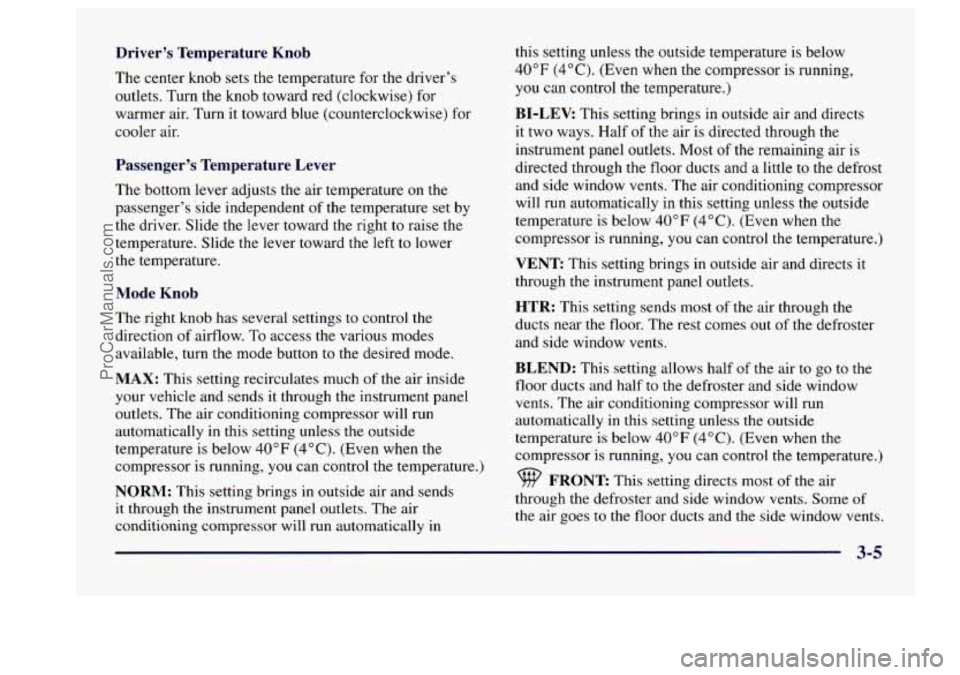
Driver’s Temperature Knob
The center knob sets the temperature for the driver’s
outlets. Turn the knob toward red (clockwise) for
warmer air. Turn it toward blue (counterclockwise) for
cooler air.
Passenger’s Temperature Lever
The bottom lever adjusts the air temperature on the
passenger’s side independent of the temperature set by
the driver. Slide
the lever toward the right to raise the
temperature. Slide the lever toward
the left to lower
the temperature.
Mode Knob
The right knob has several settings to control the
direction of airflow. To access the various modes
available, turn the mode button to the desired mode.
MAX: This setting recirculates much of the air inside
your vehicle and sends it through the instrument panel
outlets. The air conditioning compressor will run
automatically in this setting unless the outside
temperature is below 40°F (4°C). (Even when
the
compressor is running, you can control the temperature.)
NORM: This setting brings in outside air and sends
it through the instrument panel outlets. The air
conditioning compressor will run automatically
in
this setting unless the outside temperature is below
40°F
(4°C). (Even when the compressor is running,
you can control the temperature.)
BI-LEV This setting brings in outside air and directs
it two ways. Half
of the air is directed through the
instrument panel outlets. Most of the remaining air
is
directed through the floor ducts and a little to the defrost
and side window vents. The air conditioning compressor
will
run automatically in this setting unless the outside
temperature is below 40°F (4°C). (Even when the
compressor
is running, you can control the temperature.)
VENT This setting brings in outside air and directs it
through the instrument panel outlets.
HTR: This setting sends most of the air through the
ducts near
the floor. The rest comes out of the defroster
and side window vents.
BLEND: This setting allows half of the air to go to the
floor ducts and half to the defroster and side window
vents. The air conditioning compressor will run
automatically in this setting unless the outside
temperature is below 40°F (4°C). (Even when the
compressor is running, you can control
the temperature.)
FRONT This setting directs most of the air
through the defroster and side window vents. Some
of
the air goes to the floor ducts and the side window vents.
3-5
ProCarManuals.com
Page 187 of 406
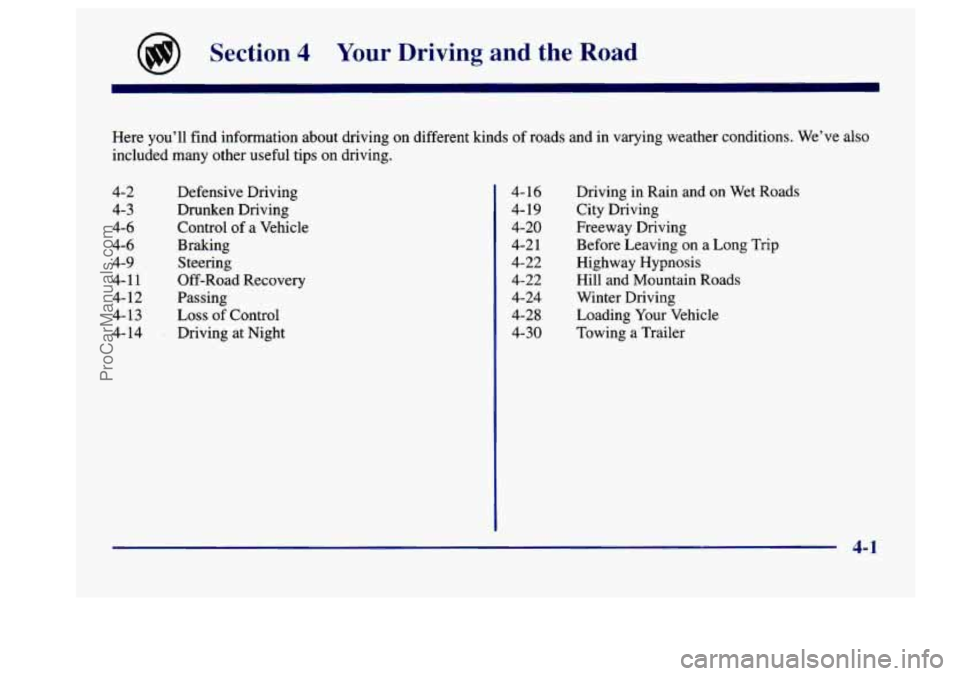
@ Section 4 Your Driving and the Road
Here you’ll find information about driving on different kinds of roads and in varying weather conditions. We’ve also
included many other useful tips on driving.
4-2
4-3
4-6
4-6
4-9
4-11
4-12
4-13 4- 14 Defensive Driving
Drunken Driving Control of a Vehicle
Braking Steering
Off-Road Recovery
Passing
Loss of Control
Driving at Night Driving in Rain and
on Wet
Roads
City Driving
Freeway Driving
Before Leaving on a Long
Trip
Highway Hypnosis
Hill and Mountain Roads
Winter Driving
Loading Your Vehicle
Towing a Trailer
4-16
4-19
4-20
4-2 1
4-22
4-22
4-24
4-28
4-30
4-1
ProCarManuals.com
Page 216 of 406
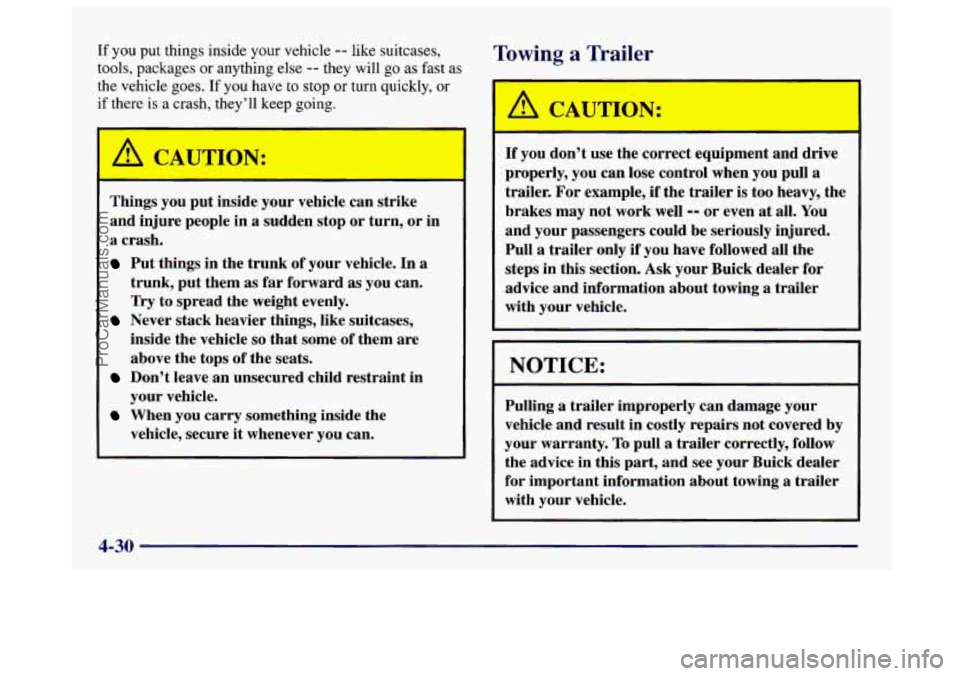
If you put things inside your vehicle -- like suitcases,
tools, packages or anything else
-- they will go as fast as
the vehicle goes. If you have to stop or turn quickly, or
if there
is a crash, they’ll keep going.
Things you put inside your vehicle can strike
and injure people in
a sudden stop or turn, or in
a crash.
Put things in the trunk of your vehicle. In a
trunk, put them
as far forward as you can.
Try to spread the weight evenly.
inside the vehicle
so that some of them are
above the tops of the seats.
Don’t leave an unsecured child restraint in
your vehicle.
When you carry something inside the
vehicle, secure it whenever you can.
Never stack heavier things, like suitcases,
Towing a Trailer
If you don’t use the correct equipment and drive
properly, you can lose control when you pull
a
trailer. For example, if the trailer is too heavy, the
brakes may not work well
-- or even at all. You
and your passengers could be seriously injured.
Pull a trailer only if you have followed all the
steps in this section. Ask your Buick dealer
for
advice and information about towing a trailer
with your vehicle.
NOTICE:
Pulling a trailer improperly can damage your
vehicle and result in costly repairs not covered by
your warranty.
To pull a trailer correctly, follow
the advice in this part, and see your Buick dealer
for important information about towing a trailer
with your vehicle.
ProCarManuals.com
Page 217 of 406
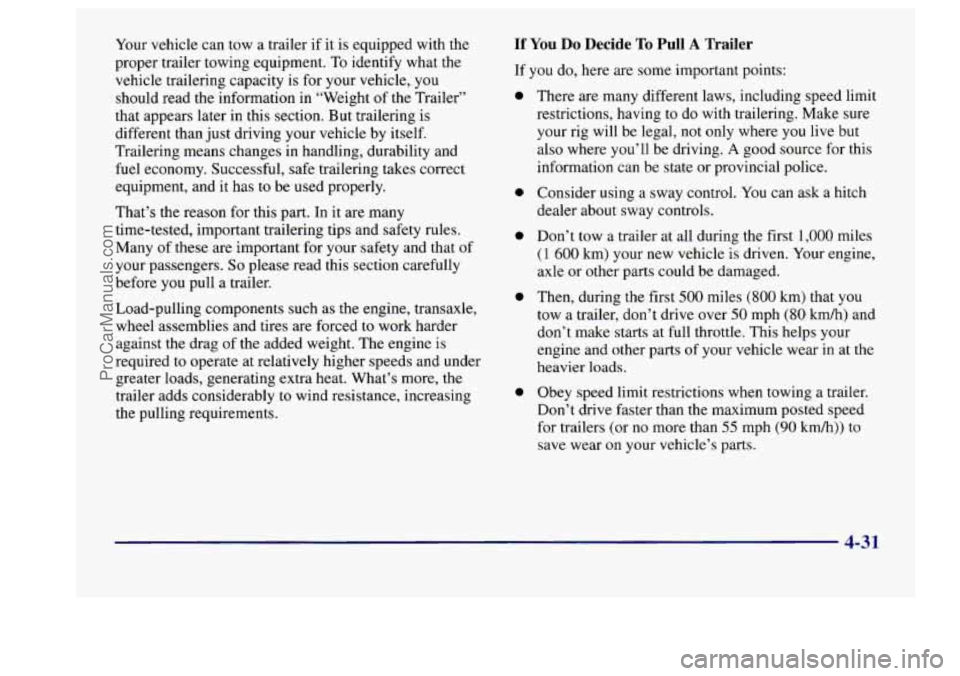
Your vehicle can tow a trailer if it is equipped with the
proper trailer towing equipment. To identify what the
vehicle trailering capacity is for your vehicle, you
should read
the information in “Weight of the Trailer”
that appears later in this section. But trailering is
different than just driving your vehicle by itself.
Trailering means changes in handling, durability and
fuel economy. Successful, safe trailering takes correct
equipment, and it has
to be used properly.
That’s the reason for this part.
In it are many
time-tested, important trailering tips and safety rules.
Many of these are important for your safety and that of
your passengers.
So please read this section carefully
before you pull a trailer.
Load-pulling components such as the engine, transaxle,
wheel assemblies and tires are forced to work harder
against the drag of the added weight. The engine is
required to operate at relatively higher speeds and under
greater loads, generating extra heat. What’s more, the
trailer adds considerably
to wind resistance, increasing
the pulling requirements.
If You Do Decide To Pull A Trailer
If you do, here are some important points:
0
0
0
0
0
There are many different laws, including speed limit
restrictions, having to do with trailering. Make sure
your rig will be legal, not only where you live but
also where you’ll be driving.
A good source for this
information can be state or provincial police.
Consider using a sway control. You can ask a hitch
dealer about sway controls.
Don’t tow a trailer at all during the first
1,000 miles
(1 600 km) your new vehicle is driven. Your engine,
axle or other parts could be damaged.
Then, during
the first 500 miles (800 km) that you
tow a trailer, don’t drive over
50 mph (80 kmh) and
don’t make starts at full throttle. This helps your
engine and other parts of your vehicle wear
in at the
heavier loads.
Obey speed limit restrictions when towing a trailer.
Don’t drive faster than the maximum posted speed
for trailers (or no more than
55 mph (90 km/h)) to
save wear
on your vehicle’s parts.
4-31
ProCarManuals.com
Page 218 of 406
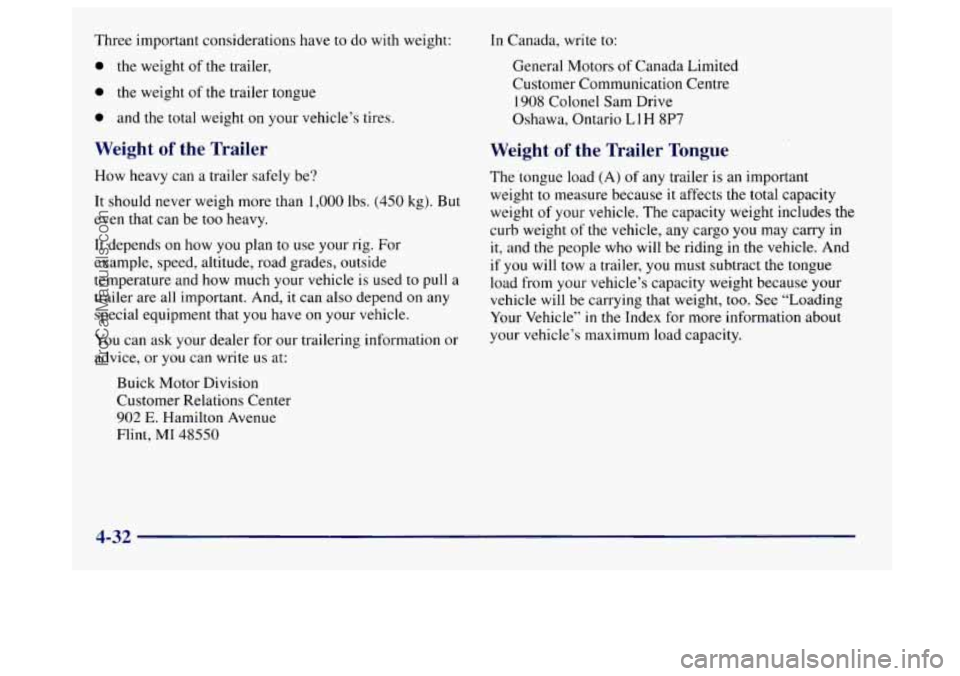
Three important considerations have to do with weight:
0 the weight of the trailer,
0 the weight of the trailer tongue
0 and the total weight on your vehicle’s tires.
Weight of the Trailer
How heavy can a trailer safely be?
It should never weigh more than 1,000 Ibs. (450 kg). But
even that can be too heavy.
It depends on how you plan to use your rig. For
example, speed, altitude, road grades, outside
temperature and how much your vehicle is used to
pull a
trailer are all important. And,
it can also depend on any
special equipment that
you have on your vehicle.
You can ask your dealer for our trailering information or
advice, or you can write
us at:
Buick Motor Division
Customer Relations Center
902 E. Hamilton Avenue
Flint,
MI 48550 In
Canada, write to:
General Motors
of Canada Limited
Customer Communication Centre
1908 Colonel Sam Drive
Oshawa, Ontario L1
H 8P7
Weight of the Trailer Tongue
The tongue load (A) of any trailer is an important
weight to measure because
it affects the total capacity
weight
of your vehicle. The capacity weight includes the
curb weight
of the vehicle, any cargo you may carry in
it, and the people who will be riding in the vehicle. And
if you will tow a trailer, you must subtract the tongue
load from your vehicle’s capacity weight because your vehicle will be carrying that weight,
too. See “Loading
Your Vehicle”
in the Index for more information about
your vehicle’s maximum load capacity.
4-32
ProCarManuals.com